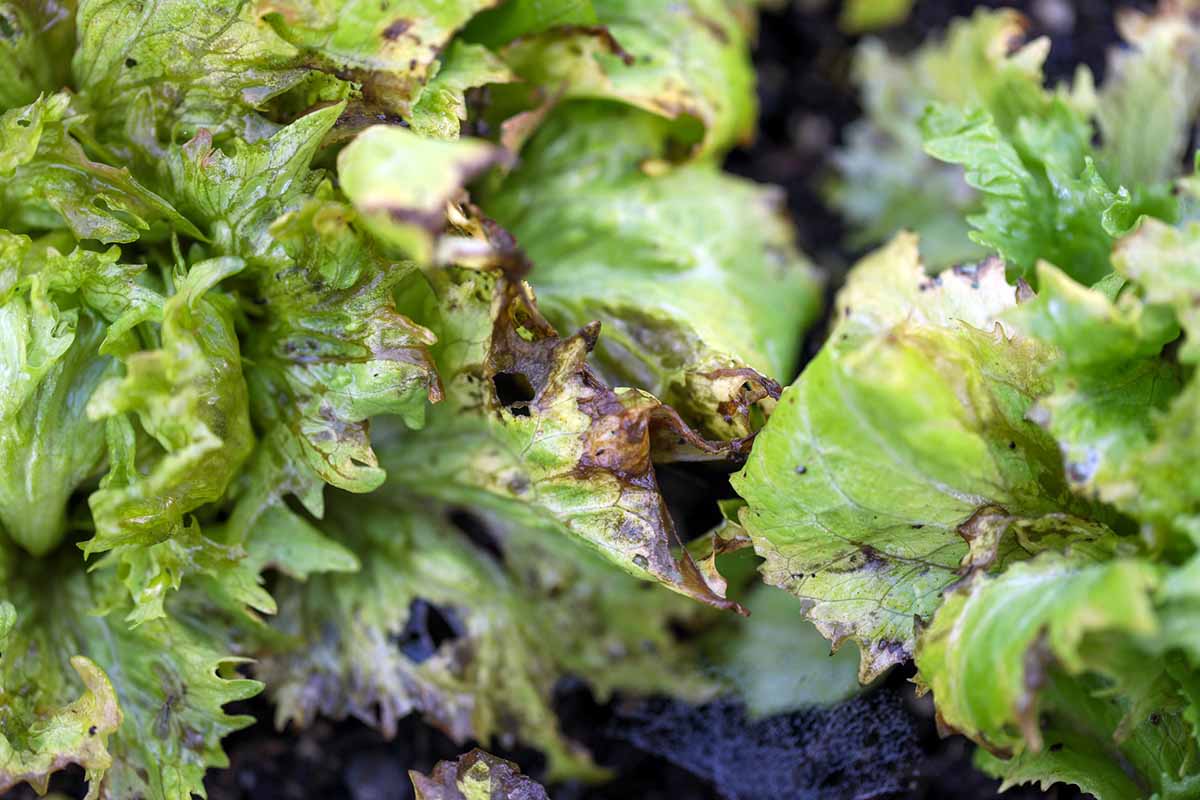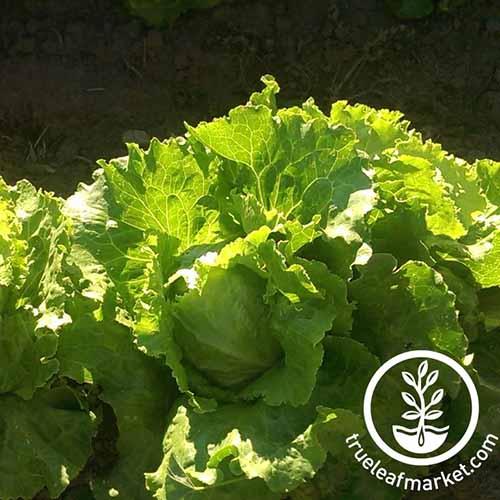
[ad_1]
Some plant diseases are worse than others. You can pretty easily dispatch powdery mildew if you catch it early.
But others, like soft rot, have no known cure and often result in a lettuce crop that’s totally inedible.


We link to vendors to help you find relevant products. If you buy from one of our links, we may earn a commission.
Sorry to start out on a downer, but I’m not going to sugarcoat things. Soft rot sucks.
When it attacks, there isn’t a whole lot that can be done and it might consign your homegrown veggies to the garbage bin.
Don’t throw your hands up in despair – though I understand the impulse. There are things you can do to prevent this disease in your garden.
And you also want to make sure your plants don’t have one of the other diseases with similar-looking symptoms that can be treated.
That’s where this guide can help. Coming right up, here’s what we’ll go over:
That salad isn’t going to make itself. Let’s figure out what’s going on with your lettuce!
What Is Soft Rot?
Soft rot is a disease that infects lettuce and many other species. It’s caused by the bacteria Erwinia persicina, Pectobacterium carotovorum, and P. polaris.
These bacteria live in living and dead plant tissue and soil, and they can be carried on tools, clothing, containers, water, soil, plants, or by insects.


When temperatures are between 65 and 95°F, the pathogens rapidly multiply.
Once temperatures climb above 95°F, or if they dip below 35°F, the bacteria stop reproducing altogether.
The pathogens typically infect a plant through wounds created by pest or mechanical damage, but they can also soak into the stomata, which are the pores of the plant, when carried by water.
In some areas, this is the most destructive disease of commercial lettuce.
And in addition to lettuce, these pathogens can infect other veggie patch plants like cabbage, celery, chilis, tomatoes, potatoes, and squash.
Symptoms
Seeds infected with soft rot will fail to germinate, but it’s impossible to tell whether this was the cause without sending them to your local extension for testing.
At any rate, there’s nothing you can do at that point except take preventative measures next time you sow.
Also, if your seeds fail or your seedlings are symptomatic, toss them out. It’s likely the whole packet is infected.


Soft rot causes seedlings to completely collapse. If you examine the young plant closely, you can usually see extensive rot at the base.
In older plants, this disease causes water-soaked brown spots to form on the leaves, as well as rot in the center of the crown. As it progresses, this can cause the plant to die.
The damage usually starts on the older, outer leaves and eventually makes its way to the center of the plant.
To make matters worse, you might think your greens escaped this dastardly disease, only to find that they start rotting after you’ve harvested.
Soft Rot, Lettuce Drop, or Bottom Rot?
Lettuce drop is a disease that looks extremely similar to soft rot. It causes brown, rotten decay on the leaves and stems, and can also be accompanied by a fetid smell.
In addition, you might also see wilted patches with a cotton-like mold growing on them on the underside of the leaves. It’s this latter symptom that sets lettuce drop apart.
Caused by Sclerotinia minor, symptoms are typically only noted on parts of the plant that are touching the soil.
Bottom rot is often confused for soft rot as well, not because the symptoms look the same but because their names are similar. Bottom rot is caused by Rhizoctonia solani, which lives in the soil and infects numerous species.
On leaves that make contact with the soil, rusty brown spots form along the lower midribs. Stems don’t become symptomatic until the entire plant collapses.
Sure that soft rot is what you’re dealing with? Let’s talk about treating it.
Treatment
This section left intentionally blank.
I kid, but there isn’t any effective treatment once your plant is infected with soft rot. It’s one of the reasons this disease is so devastating.
All you can do is pull the plant and dispose of it in a sealed garbage bag to prevent the infection from spreading.
Prevention
To start with, prevention is all about good gardening practices, like only using sterile potting media and always cleaning your pots and tools before using them.


When planting, keep your lettuce well spaced to improve air circulation, and apply straw mulch around the base of the plants to reduce water splashing.
Don’t water on top of the foliage. Make sure you’re watering at the soil level.
Next, do your best to keep pests away as they create openings for the pathogens to enter through. You should also take care when pulling out weeds not to damage your crop.
When harvesting, be super careful not to cause any damage to the foliage. Do your harvesting in the afternoon when the leaves are dry.
After harvest, store your greens between 35 and 39°F in the refrigerator to prevent the bacteria from reproducing if it’s present.
Finally, choosing resistant cultivars to begin with is your best bet at prevention.
Resistant Cultivars
There are many soft rot-resistant cultivars and new ones are coming on the market all the time.


Look for the frilly, red, oak leaf ‘Bacchus,’ the tight heads of the Batavia known as ‘Minetto,’ the ruffled iceberg ‘Empire,’ or the Bibb-type ‘Sylvesta.’
The iceberg ‘Ithica’ is another option, developed by Minotti at Cornell University in the 1960s in an effort to create a cold-hardy, disease-resistant plant that can tolerate poor soil and drought.
It won’t bolt in the summer heat either. No wonder it nabbed the All-America Selections vegetable category award in 1963.
Add it to your garden by heading to True Leaf Market. They carry packets of seeds in various sizes.
‘Magenta’ is another resistant cultivar, and it has beautiful, ruffled green and bronze foliage on a summer crisp type.
It’s a popular cultivar in the Pacific Northwest because it can handle nonstop rain for weeks and weeks without succumbing to rot. It’s certainly tougher about the winter rain in the area than I am!
Bring home seeds for planting from High Mowing Organic Seeds in quantities ranging from 500 to 500 million.
If loose leaf is your thing, ‘New Red Fire’ is pretty enough to be an ornamental. It has large, ruffled leaves that are green at the base and transition to red at the tops.
Less likely to bolt in the summer than many other cultivars, it resists fungal diseases as well as soft rot.
Visit True Leaf Market to purchase a two-gram, one-ounce, four-ounce, or one-pound package of seeds.
Banish This Dirty, Rotten Disease
Like I said, soft rot isn’t something you want to encounter. If you’re already dealing with it, my sincere condolences.
But now you’re hopefully armed with the knowledge to avoid it in the future. I know that since I started being more diligent about prevention, I’ve rarely encountered this issue.


If you’re facing this problem now, which symptoms are you seeing? Or maybe you have a favorite resistant cultivar that you’d like to share. Either way, let us know in the comments section below.
I’m hoping that you never have to face this foe again!
Once you’re on the road to happy, healthy, leafy greens, you might want to learn more about growing lettuce. Here are a few guides to get you started:
[ad_2]










